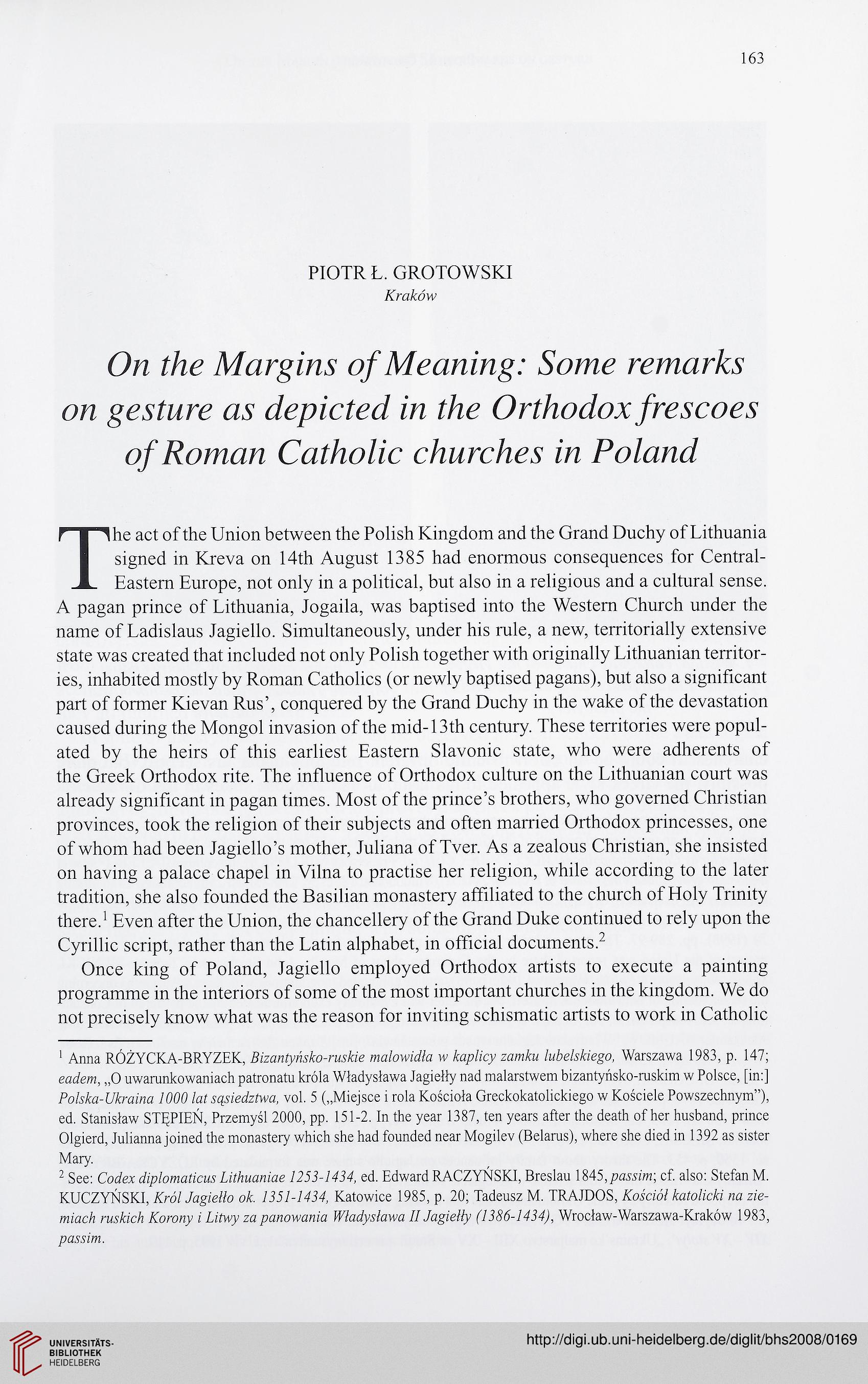163
PIOTR Ł. GROTOWSKI
KraAów
On i/ta Mnrgwj rt/'A7ar/7?/7tp.' ,STn?f ra/ttr/rk.s
on ga^fMra Jap/cfaJ /n i/ta Dri/tor/ov/fa^coa^
o/Romnn Crti/to/tc cAMrc/ta^ ;'n Po/nnJ
r H ihe act of the Union between the Polish Kingdom and the Grand Duchy of Lithuania
signed in Kreva on 14th August 1385 had enormous consequences for Central-
^ Eastern Europe, not oniy in a pohticai, but also in a religious and a cultural sense.
A pagan prince of Lithuania, Jogaila, was baptised into the Western Church under the
name of Ladislaus Jagiełło. Simultaneously, under his rule, a new, territorially extensive
state was created that included not only Polish together with originally Lithuanian territor-
ies, inhabited mostly by Roman Catholics (or newly baptised pagans), but also a significant
part of former Kievan Rus', conquered by the Grand Duchy in the wake of the devastation
caused during the Mongol invasion of the mid-13th century. These territories were popul-
ated by the heirs of this earliest Eastern Slavonic state, who were adherents of
the Greek Orthodox rite. The influence of Orthodox culture on the Lithuanian court was
already significant in pagan times. Most of the prince's brothers, who governed Christian
provinces, took the religion of their subjects and often married Orthodox princesses, one
of whom had been Jagiello's mother, Juliana of Tver. As a zealous Christian, she insisted
on having a palace chapel in Vilna to practise her religion, while according to the later
tradition, she also founded the Basilian monastery affiliated to the church of Holy Trinity
there f Even after the Union, the chancellery of the Grand Duke continued to rely upon the
Cyrillic script, rather than the Latin alphabet, in official documents.*
Once king of Poland, Jagiełło employed Orthodox artists to execute a painting
programme in the interiors of some of the most important churches in the kingdom. We do
not precisely know what was the reason for inviting schismatic artists to work in Catholic
' Anna RÓŻYCKA-BRYZEK, ßZzaniyn-sAo-raW'a nta/owtW/a w Aap/icy za/nłn /uA/s/ocgo, Warszawa )983, p. !47;
ea&m, „O uwarunkowaniach patronatu króta Władysława Jagiełły nad maiarstwem bizantyńsko-ruskim w Połsce, [in:]
Po/sia-Ułra/na 7000 /ai^^/gJzTwa, vol. 5 („Miejsce i roia Kościoła Greckokatolickiego w Kościełe Powszechnym"),
ed. Stanisław STĘPIEŃ, Przemysł 2000, pp. 151-2. !n the year 1387, ten years after the death other husband, prince
Oigierd, Juhanna joined the monastery which she had founded near Mogiiev (Betarus), where she died in 1392 as sister
Mary.
^ See: Co&xt/tp/ontaO'cMS'Th/tMan/ae 7253-7437, ed. Edward RACZYŃSKI, Breslau 1845,pas^On; cf. also: Stefan M.
KUCZYŃSKI, Kró/Jag/e//o oł. 7337-7434, Katowice 1985, p. 20; Tadeusz M. TRAJDOS, KoA/ó/ Æato/ZcC no zm-
nn'ac/? ru.sAte/? Korony i L/iwy za panowania R7a<7}'s7awa 77 Jag/a//y (7330-7434), Wrocław-Warszawa-Kraków 1983,
pa^ńn.
PIOTR Ł. GROTOWSKI
KraAów
On i/ta Mnrgwj rt/'A7ar/7?/7tp.' ,STn?f ra/ttr/rk.s
on ga^fMra Jap/cfaJ /n i/ta Dri/tor/ov/fa^coa^
o/Romnn Crti/to/tc cAMrc/ta^ ;'n Po/nnJ
r H ihe act of the Union between the Polish Kingdom and the Grand Duchy of Lithuania
signed in Kreva on 14th August 1385 had enormous consequences for Central-
^ Eastern Europe, not oniy in a pohticai, but also in a religious and a cultural sense.
A pagan prince of Lithuania, Jogaila, was baptised into the Western Church under the
name of Ladislaus Jagiełło. Simultaneously, under his rule, a new, territorially extensive
state was created that included not only Polish together with originally Lithuanian territor-
ies, inhabited mostly by Roman Catholics (or newly baptised pagans), but also a significant
part of former Kievan Rus', conquered by the Grand Duchy in the wake of the devastation
caused during the Mongol invasion of the mid-13th century. These territories were popul-
ated by the heirs of this earliest Eastern Slavonic state, who were adherents of
the Greek Orthodox rite. The influence of Orthodox culture on the Lithuanian court was
already significant in pagan times. Most of the prince's brothers, who governed Christian
provinces, took the religion of their subjects and often married Orthodox princesses, one
of whom had been Jagiello's mother, Juliana of Tver. As a zealous Christian, she insisted
on having a palace chapel in Vilna to practise her religion, while according to the later
tradition, she also founded the Basilian monastery affiliated to the church of Holy Trinity
there f Even after the Union, the chancellery of the Grand Duke continued to rely upon the
Cyrillic script, rather than the Latin alphabet, in official documents.*
Once king of Poland, Jagiełło employed Orthodox artists to execute a painting
programme in the interiors of some of the most important churches in the kingdom. We do
not precisely know what was the reason for inviting schismatic artists to work in Catholic
' Anna RÓŻYCKA-BRYZEK, ßZzaniyn-sAo-raW'a nta/owtW/a w Aap/icy za/nłn /uA/s/ocgo, Warszawa )983, p. !47;
ea&m, „O uwarunkowaniach patronatu króta Władysława Jagiełły nad maiarstwem bizantyńsko-ruskim w Połsce, [in:]
Po/sia-Ułra/na 7000 /ai^^/gJzTwa, vol. 5 („Miejsce i roia Kościoła Greckokatolickiego w Kościełe Powszechnym"),
ed. Stanisław STĘPIEŃ, Przemysł 2000, pp. 151-2. !n the year 1387, ten years after the death other husband, prince
Oigierd, Juhanna joined the monastery which she had founded near Mogiiev (Betarus), where she died in 1392 as sister
Mary.
^ See: Co&xt/tp/ontaO'cMS'Th/tMan/ae 7253-7437, ed. Edward RACZYŃSKI, Breslau 1845,pas^On; cf. also: Stefan M.
KUCZYŃSKI, Kró/Jag/e//o oł. 7337-7434, Katowice 1985, p. 20; Tadeusz M. TRAJDOS, KoA/ó/ Æato/ZcC no zm-
nn'ac/? ru.sAte/? Korony i L/iwy za panowania R7a<7}'s7awa 77 Jag/a//y (7330-7434), Wrocław-Warszawa-Kraków 1983,
pa^ńn.




